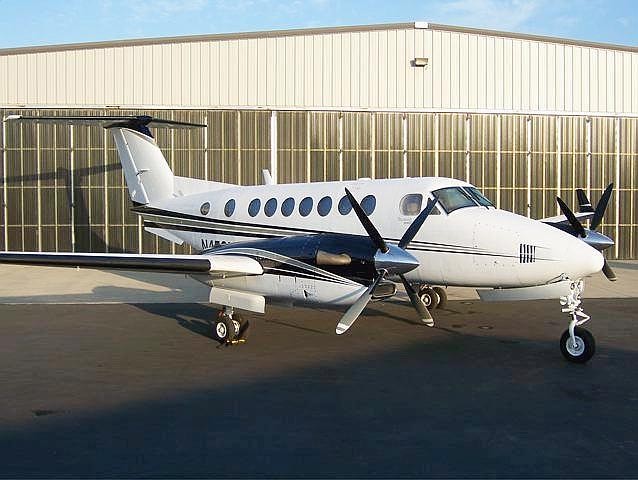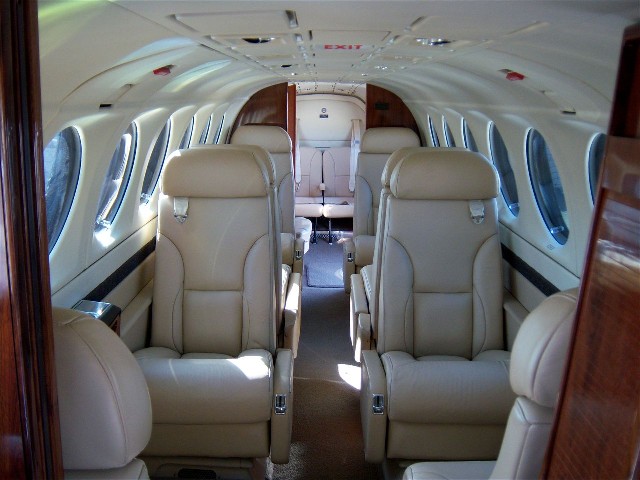


Aircraft Description
Background/History
In January 1964, the first Beechcraft 65-90 took to the air. Based on the piston-engined Model 65 Queen Air, the -90 featured the then-new Pratt & Whitney Canada PT6A turboprop powerplants in place of the earlier 65’s Lycoming flat-six piston engines. A pressurized model was developed, and was designated the King Air 90. Many variants followed including the stretched King Air 100 and the further-stretched Super King Air 200 and 300 models which utilized more powerful versions of the PT6A. At the 1989 NBAA convention, Beech introduced the Super King Air 350. This still-larger member of the Super King Air line is 46.7 ft. in length, two feet longer than the 300 and eleven feet longer than the C90 with a wingspan of nearly 58 feet. The Super King Air 350 received FAA certification in February 1990 under FAR Part 23 as a commuter category aircraft, greater than 12,500lbs. gross weight and requires two pilots. Over 500 were produced and delivered through 2007.
Power
The Super King Air 350 is powered by two Pratt & Whitney Canada PT6A-60A turboprop engines rated at 1,050shp at ISA +10C, each driving a Hartzell four-bladed, full-feathering, reversible, constant speed propeller. Engine inspection interval is 3,600 hours.
Avionics
The Super King Air 350 is available with either a three-tube or five-tube Collins EFIS panel, Collins APS-65 autopilot, encoding altimeter with alerter/preselect, Collins ALT-50A radio altimeter, dual Collins Pro Line II comm/nav/ident radios with dual glideslopes and DME, Collins ADF-60A ADF, and Collins WXR-270 color weather radar.
Design Features
The Super King Air 350 is a pressurized, twin-engine turboprop business aircraft configured as a cantilever low-wing monoplane with a T-tail and aft ventral fin. It has retractable tricycle landing gear with dual wheels on each main unit. The 350 series incorporates a 34- inch stretch of the King Air 300 fuselage and has one additional window per side. The wingspan has been increased by 3 feet over that of the model 300, and 24-inch graphite composite winglets have been added to the wingtips to reduce drag at higher angles of attack as in takeoff and climbout. The Super King Air 350 benefits from recent improvements throughout the King Air line including reduced cabin noise levels, a three-bus electrical system, and a “ground fine” range of propeller control to minimize the need for brake use during taxi.
Accomodations
The cabin of the Super King Air 350 has seating for eight passengers in a double club arrangement. The aft lavatory also has a belted seat. The seats are fully adjustable and reclining, and track in and out from the wall. Folding work tables, cupholders, and individual fresh air inlets are included. A large stand-up baggage area is located at the aft end of the cabin.
| General | King Air 350, B300 | |||
|---|---|---|---|---|
| Category | Multiengine Turboprop > 12,500 lbs. | |||
| Years Aircraft Manufactured | 1990 – current | |||
| Serial Number Range | FL-0001-0631 (up) | |||
| Retail High Price | $5,000,000.00 / 3,923,500.00€ | |||
| Retail Low Price | $2,295,000.00 / 1,800,886.50€ | |||
| Characteristics | King Air 350, B300 | |||
| Seating | 1+9/11 | |||
| Wing Loading | 48.4 | |||
| Power Loading | 7.1 | |||
| Noise(EPNdB): Takeoff/Sideline/Approach | 72.1 | |||
| External Dimensions (ft) | King Air 350, B300 | |||
| External Length | 46.7 | |||
| External Height | 14.3 | |||
| External Span | 57.9 | |||
| Internal Dimensions (ft) | King Air 350, B300 | |||
| Internal Length (Overall/Net Height) | 19.5/19.5 | |||
| Internal Height | 4.8 | |||
| Internal Width (Max/Floor) | 4.5/4.1 | |||
| Baggage | King Air 350, B300 | |||
| External: Cu.Ft./Lb. | 55.3/550 | |||
| External: Cu.Ft./Lb. | N/A | |||
| Power | King Air 350, B300 | |||
| Engines | 2 P&WC PT6A-60A | |||
| Output (lbs ea.)/Flat Rating | 1,050shp/ISA+10 | |||
| Inspection Interval | 3,600t | |||
| Data based on latest manufactured year | ||||



